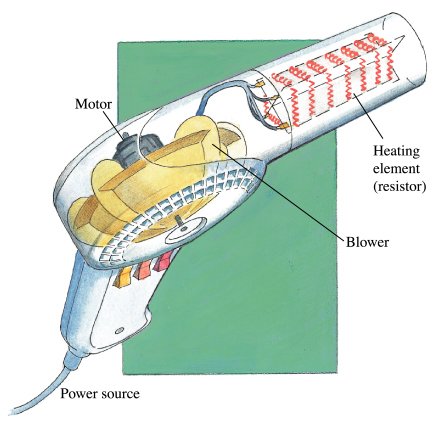Electricity: Moving charges
Posted on October 24th, 2008 by Technology Department
ENERGY CHANGES IN A SIMPLE ELECTRIC CIRCUIT
The electric power in watts represents the rate at which energy is converted from electrical energy to some other form of energy, e.g., mechanical energy, heat, light, etc. The simple formula for the power ( in a resistor ) in a direct current (D C) circuit is given by the product of the voltage between its terminals and the electric current that passes through it.
P = V x I
In the international system P is measured in Watts, V in volts and I in Amps.
The water analogy still applies. Think of voltage as pressure and the Amps as outflow of a river
The running water falls into the buckets attached to the wheel and forces the wheel to turn, producing energy. You can increase the power generated by:
1º Increasing the pressure of the water that falls into the buckets; the wheel will turn faster, generating more power.
The higher up the water spout is from the wheel beneath it, the higher the fall of the water and the higher the pressure ( More voltage applied )
2º Increasing the flow rate and the extra water hitting the buckets will make the waterwheel turn faster, producing more energy.
” We increase the current because the water flow has been increased ”
A very good example of a home appliance with a high wattage is a hair dryer.
It needs only two parts to generate the hot air that dries your hair:
* a heating element
* a motor-driven fan
Hair dryers use the heating element ( a simple wire with some resistance ) to transform electric energy into heat.
How does it work?. The whole mechanism is really very simple: 1. When you plug in the hair dryer, current flows through the hair dryer and “feeds” either the motor or the heater. 2. The heating element gives out heat
3. The current makes the electric motor spin, which turns the fan. 4. The fan is made of plastic and the airflow generated by it is directed down the barrel of the hairdryer, through the heating resistance. 5. As the air flows through the heated resistance, the heated air generated streams out of the end of the barrel.
Examples and Exercises:
First of all, watch this video about electric power
1º Example
A kettle. Jim has to travel abroad as part of his job. Knowing that not all hotels in the USA provide a ‘Welcome Tray’ ( coffee , tea and sugar ) he buys a kettle so he can make tea for himself as often as he wants. There is a label stuck to the kettle ( see figure on the left ). On the paper is written:
‘Takes less than 3 minutes to boil at 230 V and 6 minutes at 120 V’
1. Why would boiling some water in the Travel kettle in San Francisco (power supply: 120 V) take longer than in London (230 V).
2. Calculate the current through the heater in each city.
3 When Jim leaves San Francisco, Jim forgets to switch over the voltage setting to 230 V. Do you think it is a problem? Do you think the kettle could be damaged by leaving it at 120 V ?
4.A Fuse is a component used to protect the appliance from current overload. Calculate a suitable value to install in the plug to protect the travel kettle from overheating. Answers
But it cost money to produce energy and we have to pay for it.
We have seen that: Power P = E ⁄ t , so Energy is P x t ( where P is in watts, Energy ‘E’ is in joules, and time ‘t’ is in seconds ). The formula is as simple as this: 1 W = 1 J/s so 1 Joule = 1W x 1 Second.
The joule is a very small unit of energy to use when dealing with domestic electricity. A unit of energy called the kilowatt per hour (kW h) is used instead.
1kwh = 1000 W x 1 h = 1000 W x 3600 s = 3600000 Ws = 3600 kws ( as 1 kw = 1000 w).
The kwh is the energy unit used in the home to measure the use of energy. The more energy you use, the more money you have to pay to your local electrical company
Exercises:
1. A heater has a power rating of 1000 W. It operates on 230 V mains. What current does it draw?
2º A 2000 W appliance operates for 3 hours. How many kilowatts per hour of energy does it use?
3º A 75 W lamp is operating for 40 minutes. How many kilowatts per hour of energy does it use?. How much do you pay if 1kwh = 0,15€
4º An electric cooker has two 500 W plates, a 1 kW grill and a 2 kW oven. It operates on 230 V mains. Is a 30 A fuse suitable for this cooker?. How much do you pay every day if the grill is on for 30 minutes every day and the oven for 60 minutes?
Electricity always take the shortest path (way) to the ground.
Electricity Activities
Outflow : of a river is the volume of water transported by it in a certain amount of time.
Gutter: a narrow channel which drive the water.
Spout : a pipe or a conductor through which a liquid is conveyed in a stream

